Alfred Edward Gaby
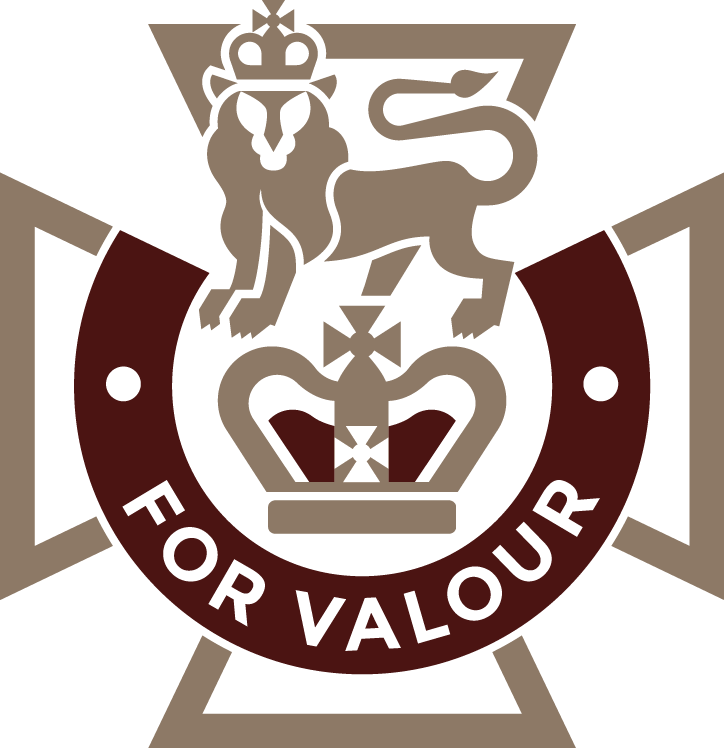
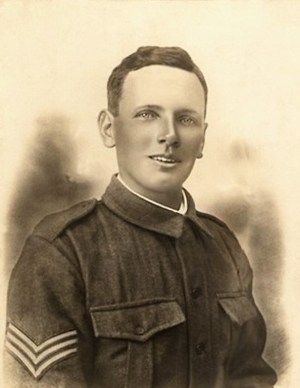
Sgt Alfred Edward Gaby VC
Victoria Cross Recipient
World War One
Born – 25 January 1892 – Ringarooma, Tasmania
Lived – Katanning, Western Australia
Died – 11 August 1918 (aged 26) – Lihons, France [2]
Service/branch – Australian Army
Years of service – 1916–1918
Rank – Lieutenant
Unit –
28th Battalion (Australia)
Battles/wars –
First World War
Western Front
Battle of Amiens
Awards –
Victoria Cross
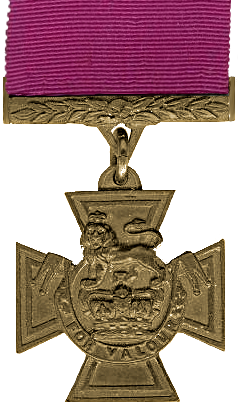
Alfred Edward Gaby VC (25 January 1892 – 11 August 1918) was an Australian recipient of the Victoria Cross, the highest and most prestigious award for gallantry in the face of the enemy that can be awarded to British and Commonwealth forces.
He was born in Ringarooma, Tasmania to Alfred Athelston and Adelaide Gaby. He worked as a farmer and then a labourer before enlisting in the Australian Imperial Force [2] in 1916 and volunteering to serve overseas. Serving initially in the ranks, Gaby was quickly promoted, having previously served as a part-time soldier before the war, and was eventually commissioned in 1917.
He was one of 64 Australians to receive the award for their actions during the First World War, receiving it for his actions during an attack around Villers-Bretonneux in France during the Battle of Amiens that took place at the start of the Allied Hundred Days Offensive. He was killed three days later, at the age of 26, while leading another attack around Lihons.
Born in Springfield near Ringarooma, Tasmania, he was the seventh son of Alfred Gaby, a farmer, and his wife Adelaide, née Whiteway. Whilst working on the family farm, he joined the militia and served for three years with the 12th Infantry Battalion (Launceston Regiment). Two of his brothers had served overseas during the Boer War.[2]
Military Service
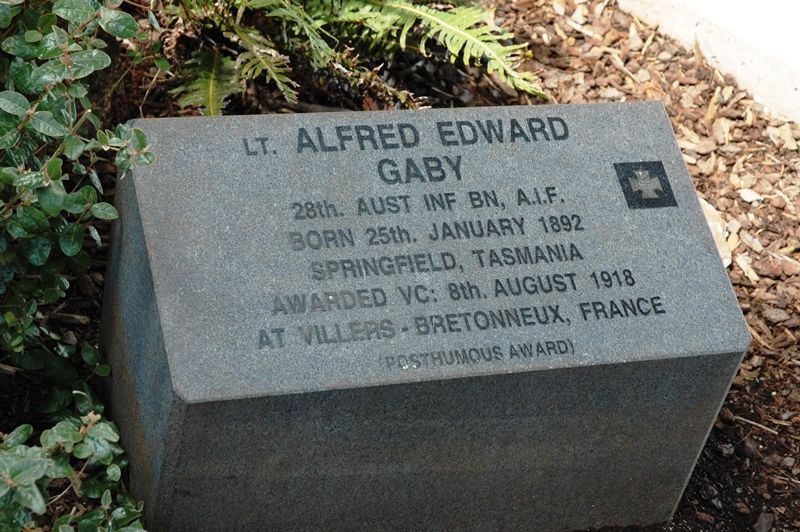
Gaby was labouring in Katanning, Western Australia, when he enlisted in the Australian Imperial Force (AIF) in January 1916. He had been twice previously rejected for enlistment. He embarked from Fremantle on board HMAT A38 Ulysses in April 1916, and was assigned to the 28th Battalion – an infantry battalion that was formed mainly from Western Australian recruits, which was assigned to the 7th Brigade, 2nd Division – as part of the unit’s tenth draft of reinforcements.
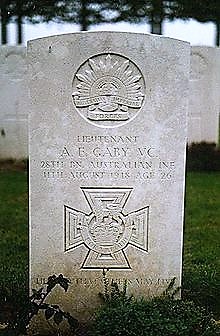
Over the course of the next twelve months while in the front line on the Western Front [2], he was promoted through the ranks at a rapid speed, reaching sergeant before being selected for officer training in the United Kingdom. After graduating in May 1917 he was commissioned as a second lieutenant in April 1917. Further promotion came in September 1917 when he made lieutenant. On 29 October 1917, Gaby was gassed during the 28th Battalion’s involvement in the Battle of Passchendaele.
VICTORIA CROSS CITATION
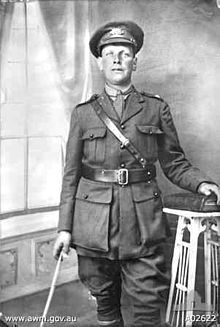
Alfred Edward Gaby VC
Gaby was 26 years old, and serving as a lieutenant in the 28th Battalion, AIF, when the following deed took place for which he was awarded the VC. On 8 August 1918, at the start of the Allied Hundred Day Offensives. Gaby was acting as commander of his battalion’s ‘D’ Company, which was committed to an attack around Villers-Bretonneux, France during the Battle of Amiens.
When the advance was checked by a large German force about 40 yards beyond the wire, Gaby found a gap and approached the strong point under heavy machine-gun and rifle fire. He emptied his revolver into the garrison, drove the crews from their guns and captured 50 prisoners and four machine-guns. Three days later, on 11 August 1918 while leading his men during an attack at Lihons he was killed.
His VC citation from the London Gazette of 30 October 1918 reads:
For most conspicuous bravery and dash in attack, when on reaching a wire in front of an enemy trench, strong opposition was encountered. The advance was at once checked the enemy being in force about 40 yards beyond the wire, and commanding the gap with machine guns and rifles. Lieutenant Gaby found another gap in the wire, and, single handed, approached the strong point while machine guns and rifles were still being fired from it. Running along the parapet, still alone, and at point blank range, he emptied his revolver into the garrison, drove the crews from their guns, and compelled the surrender of 50 of the enemy with four machine guns.
He then quickly reorganised his men, and led them on to his final objective, which he captured and consolidated. Three days later, during an attack, this officer again led his company with great dash to the objective. The enemy brought heavy rifle and machine gun fire to bear upon the line, but in the face of this heavy fire Lieutenant Gaby walked along his line of posts, encouraging his men to quickly consolidate. While engaged on this duty he was killed by an enemy sniper.

He is buried at the Heath Cemetery in Harbonnieres, France. He was unmarried at the time of his death. The Alfred Gaby ward at the former Repatriation General Hospital, Hollywood was named in his honour.
FROM THE NEWSPAPERS
MEMORIALS UNVEILED
V.C. Tablet to late Lieut A. E. Gaby.
Southern Districts Advocate
15 November 1920 – P2
The town hall, Katanning, was filled on Sunday morning last to witness the unveiling of the tablet erected to the memory of the late Lieut A. E. Gaby, V.C., by his comrades of the local branch of the R.S.L. On the platform were Canon Burbidge, and Reverends J. R. Edmonds and C.E. Hipwell. Also on stage was the Katanning Brass Band, which opened the proceedings by playing the National Anthem. It then accompanied the audience in the hymn “O, God Our Help in Ages Past.”
A short prayer was offered by Rev Edmonds, and a reading by Canon Burbidge, after which the band joined with the assemblage in the beautiful hymn, “Lead Kindly Light.” The Rev. Hipwell then made a stirring address and Colonel Collett, C.M.G., D.S.O., Y.D., who was the officer commanding Lieutenant Gaby’s battalion uncovered the tablet. It was a splendid replica of the Victoria Cross on a marble slab, bearing the inscription: “To the memory of Lieut. A. E. Gaby, V.C., 28th Battalion, late of Nyabing, killed in action at Herleville Ridge, France, on August 11th 1918. Erected by Katanning sub-branch R S.L.” The Colonel gave the following particulars regarding the service of the late Lieut Gaby, as under:
“No. 4053 E.D. Pay Sergeant A. E. Gaby embarked from Australia with 10/28th Battalion in April, 1916. Arrived in Egypt in May and was stationed with the 7th Training Battalion until June, 1916, when the Training Battalion as a whole embarked on the S.S. “Minetonka” for
England. Disembarked at Devonport and entrained for Salisbury Plains. Sergeant Gaby marched out on draft to France about the middle of July and joined the Battalion in time to take part in Pozieres stunt. Was promoted corporal at Dermancourt about 1st November 1916, and took part in Flérs stunt on November 5th 1916. Remained with Battalion through the time spent at Martinpuich in front of Butte deWarlincourt, was in Le Sarr, and took part in the Mall Trench attack. Was promoted to Commissioned rank at Shelter Wood camp on 17th April 1917. Took part in the Bapaume buainess, was at Vaulx, Lagincourt and Morieul. Next to Bllecourt on 3-5-17. Lieut Gaby was detached with the Engineers together with a party of N.C.O’s and men and did not join the Battalion until it returned to rest. The job they were engaged upon was very distasteful, their duty being to carry Bangalore Torpedoes from the rear right up and place them under the enemy’s wire, so that at a given signal the whole could be sent off together. This job was particularly dangerous from every point of view as the approaches were impassable.
The party suffered only two casualties and were congratulated on their pluck and achievements. The next stunt of note was Ypres. On 20th September, 1917, Lieut Gaby took part in the attack on Polygon Wood and remained in the line during the whole tour. Again, when the Battalion was at Zonnebecke, he went in and was sent back to rest. This rest lasted about two days when, on account of a number of casualties in officers he was again sent for and remained in the line to the end of the tour.
His work during this period was particularly sound and called for much favorable comment from the men in the ranks. Some anxiety was entertained on being relieved for his safety, but he eventually turned up with a machine gun and three panniers which he secured from a post that had been blown out and all hands killed. He had scoured the whole of the sector in the hope of picking up strays etc. I rather lost touch at this stage but fancy he took part in the Morlancourt stunt on 10th June, 1916.
He was in “D” Company at Villiers Brettenneux when we were holding the line and took charge of the company on August 8th,19l8, when the big push commenced. He did well on the 8th, 9th, and :10th, and on the11th, when the attack was ordered his Company was particularly weak, so much so, that he was not able to send them over in the usual extended order but had to organise them in to small groups giving each group direction and objective. The objective was taken and it was.at this time when he met his death.
When an attack had reached the front rank of the enemy trench he was met by very strong opposition from the Huns not more than 40 yards off. He found a gap, and notwithstanding machine gun and rifle fire, he charged single handed and, running along the parapet emptied his revolver at point blank range. By his wonderful pluck and initiative he drove the crews from their guns and compelled the surrender of forty men, together with four machine guns. Unfortunately the brave fellow was shot by a sniper three days later. He was buried in front of Famerville.”
The band then played the “Dead March” and the “Last Post” was sounded by Bugler Lawson, after which Rev. Edmonds pronounced the benediction, and the proceedings closed with the National Anthem. Wreaths were placed, underneath the tablet by Mrs Higman and Mr A, Meldrum.
CEREMONY AT NYABING
Southern Districts Advocate
15 November 1920 – P2
At the conclusion of the local ceremony an adjournment was made to the railway station where the special train, chartered by the Katanning Fallen Soldiers’ Memorial Committee, was waiting to convey visitors to Nyabing.
A large crowd took the opportunity of visiting the eastern suburb, amongst whom were a goodly number of returned men in uniform, while the engine was manned by two men who served in the late war with the Railway-Corps. On arrival at Nyabing, luncheon was served to the visitors and, after the inner man had been satisfied, all proceeded to the spot where the unveiling was to take place.
In opening the proceedings, Mr. E. A. Gaby, in a brief address thanked the people of Katanning for having turned up in such large numbers. Mr Thomson, M.L.A., member for the district, in a short speech called Colonel Collett to unveil, the memorial. The Colonel, in performing the ceremony, stated it was an honor to be asked to come to Nyabing for this purpose.
Several of the men, whose names appeared on the tablet, had fought whom he had known personally. He then read out an account of the act of bravery for which the Lieutenant was awarded the Victoria Cross. The names on the tablet were : R. Applin, A. H. Curristors, R. G. Cuthbert, H. Fisher, A. E. Gaby, V.C., W. C. George, A. C. Jones, M.M., F. A. Middleton, J. A. Macrow, H. D. Noon, P. E. Russel, E. Seal, G. Saunderson, J. G. Thomson, E. Wilson, B. Young. On the bottom of the stone were the simple words “Greater Love Hath no Man.”
Wreaths were to hand from Mrs. Bookman and Mr. A. Thomson, M.LA. The memorial is situated in the centre of an avenue of trees planted and dedicated to the memory of the heroes who fell in the great war, 1914-18, by the children of Nyabing.
After the band had played the “Dead March” and Bugler Lawson had sounded the “Last Post,” the company adjourned to the hall where a meeting was held for the purpose of appealing for funds to erect the memorial in Katanning, Mr. E. A. Gaby, presiding.
Mr. G. McLeod, chairman of the Katanning Fallen Soldiers’ Memorial Fund briefly outlined the objects of the fund, while the secretary, Mr. I. Synott explained in detail the progress to date and the amount needed. Mr A. Thomson, M.L.A. then made a stirring appeal which resulted in approximately £100 being raised for the fund. Mr Thomson, on behalf of the visitors, thanked the ladies of Nyabing for the splendid repast provided, and hoped that when the Katanning memorial was unveiled all Nyabing would come to Katanning when the people would reciprocate.
Lieutenant Alfred Gaby
From the Monument Australia website:
The bronze tablet, in the form of a Victoria Cross, commemorates Lieutenant Alfred Edward Gaby who was awarded the Victoria Cross (V.C.) during World War One.
Alfred Edward Gaby (1892-1918), soldier and labourer, was born on 25 January 1892 at Springfield, near Ringarooma, Tasmania. Before the outbreak of World War One , Gaby followed one of his brothers to Western Australia where he worked as a labourer at Katanning.
Gaby was acting as commander of ‘D’ Company when, as part of the 2nd Division, his battalion was engaged in the great allied offensive of 8 August 1918. The 28th Battalion attacked German positions east of Villers-Bretonneux and in the course of this action Gaby showed conspicuous bravery and dash in leading and reorganizing his company when it was held up by barbed wire entanglements. He found a gap in the wire, and single-handed, approached an enemy strong point in the face of machine-gun and rifle fire. ‘Running along the parapet, still alone, and at point-blank range, he emptied his revolver into the garrison’, driving the crews from their guns and capturing fifty men and four machine-guns. He then reorganized his men and captured his objective. On 11 August 1918 in another attack near Lihons, during which he again showed bravery and coolness in engaging an enemy machine-gun position, he was killed by sniper fire.
He was awarded the Victoria Cross posthumously.
On Sunday an impressive service was held in the Katanning Town Hall, the occasion being the unveiling of a memorial tablet to Lieutenant A. E. Gaby, V.C., of the 28th Battalion A.I.F. The unveiling ceremony was performed by Lieut.-Colonel H. B. Collett, C.M.G., D.S.O., V.D., late CO. of the 28th Battalion, and there were present a large number of returned soldiers, the majority of whom were in uniform, as well as of the general public. The form the memorial has been given as a bronze Victoria Cross, an exact replica of the original, two feet long. mounted on a white marble slab bearing an appropriate inscription and stating that the Katanning branch of the R.S.L. had erected it to the memory of a fallen comrade.
The West Australian (Perth), 20th November 1920.
Note: A plaque related to the unveiling is located on the Katanning War Memorial.
Lest We Forget
